
ISSN: 0729-3682 (Print) 2150-6841 (Online) Journal homepage: https://www.tandfonline.com/loi/rapl20


ISSN: 0729-3682 (Print) 2150-6841 (Online) Journal homepage: https://www.tandfonline.com/loi/rapl20
To cite this article: Julian Alexander Bolleter (2018) The consequences of three urbanisation scenarios for northern Australia, Australian Planner, 55:2, 103-125, DOI: 10.1080/07293682.2019.1620302
To link to this article: https://doi.org/10.1080/07293682.2019.1620302

Published online: 04 Jun 2019.

Submit your article to this journal


Article views: 499


View related articles

View Crossmark data


Citing articles: 2 View citing articles


Full Terms & Conditions of access and use can be found at https://www.tandfonline.com/action/journalInformation?journalCode=rapl20
JulianAlexanderBolleter
AustralianUrbanDesignResearchCentre,UniversityofWesternAustralia,Perth,Australia
ABSTRACT
TheAustralianfederalgovernmentwhitepaper ‘Ournorth,ourfuture’ projectsthatnorthern Australia’spopulationcouldreach5,000,000by2060.Thisrepresentsanalmostfour-fold increaseinpopulation(anadditional3,700,000people)allwithinthenext41years.Given theambiguitiesintheWhitepaperaboutthedistributionofthispopulation,thispaper venturesthreesettlementpatternscenariostoexploretheissuesthesemaypose.Thepaper concludesthatpopulationgrowthofthescaleprojectedwillrequirecomprehensive,long termplanning – withoutsuchplanningthescaleofpopulationgrowthprojectedcouldresult innegativeenvironmentalandsocietalconsequences.Assuch,thedisciplineofplanningin Australiashouldbeawareofthisemergingsituation.
Introduction
ThispaperdefinesnorthernAustraliaastheregion northoftheTropicofCapricorn(23.5′ Slatitude). Thisencompassesanareaof3,500,000squarekilometres,or45%ofAustralia’stotallandmass,yethouses only5%ofitspopulation.Despiteitssparsehabitation, northernAustraliacontainsseveralsmallcities,major towns,andremotecommunities.InWesternAustralia, themajorcentresincludethetouristtownofBroome (population15,000)andtheminingtownsofPort HedlandandKarratha(population15,000and 17,000,respectively).IntheNorthernTerritory, theseincludetheadministrativecityofDarwin (106,000),andinQueensland,thelifestylecitiesof Cairns,TownsvilleandMackay(population140,000, 170,000and115,000,respectively),amongothers (Figure1).
Proponentsofnortherndevelopmentenvisage often-extremepopulationgrowth,inpart,becauseof theregion’sgrowinggeopoliticalimportance.Indeed, northernAustraliasitsattheintersectionofthe ‘two mostimportantglobalaxesofthetwenty firstcentury: Asiaandthetropics’ (Roux,Faubell,andMcGauchie 2014,xi) – tworegionsthatareprojectedtogrowsignificantlyintermsofpopulationandeconomicmight. Nonetheless,northernAustraliacontinuestobeconsidereda ‘frontier’ commensurate,tosomedegree, withhistoricfrontierssuchastheAmericanWest, theCanadianWestandNorth,China’sSinkiangand Manchuria,andtheSouthernAfricanveldt(Cohen 2000,256).Becausehistoricalattemptsatintensive developmenthavebeensporadic,northernAustralia offersthelargestintact ‘savannaremainingonEarth, anextraordinarilyvast,naturallandscapewitha
ARTICLEHISTORY
Received20June2018
Accepted6May2019
KEYWORDS NorthernAustralia; populationgrowth;climate change;settlementpatterns; scenarioplanning
richbiodiversityofinternationalsignificance ’ (Nix etal. 2013,85).Indigenousculturallifeinnorthern Australiaalsoremainsstrong,boundtothelandscapes, rivers,andwildlifethatthesetraditionalownershave managedfortensofthousandsofyears.Nonetheless, indigenouspeopleinnorthernAustraliaalsocontinue toexperience ‘chronicdisadvantage’ (Raupachetal. 2012,29).
Governmentplansfordevelopingnorthern Australia
Currentfederalgovernmentplanningfornorthern Australiaisencapsulatedinthe ‘Ournorth,ourfuture: whitepaperondevelopingNorthernAustralia’ (AustralianGovernment 2015,1).Adoptingagenerally pro-developmentstance,inlinewiththeconceptualisationofthenorthasaplaceofeconomicbountyand opportunity,thewhitepaperdeclaresthatitshould ‘standthetestoftime – itshouldbethe first,and last,whitepaperforthenorth’ (AustralianGovernment 2015,1).Soastofasttrackgrowth,thefederal governmenthascommittedtoprovidinganew$5billionNorthernAustralianInfrastructureFacilitytoprovideconcessionalloansfortheconstructionofmajor infrastructuressuchasports,roads,rail,pipelines, andelectricityandwatersupply(AustralianGovernment 2015, 8).Whilethewhitepaperismuteonissues ofsettlementpatterns,therearegeneralstatementsthat alludetothegovernment’ssupportforsignificant urbanisation.Asthereportdeclares:
Developmentwillrequiremanymorepeoplelivingin thenorth.Transformationwillnothappenifitspopulationinchesupbyafewhundredthousandoverthe next20years.Itwouldremainahighcost,small-
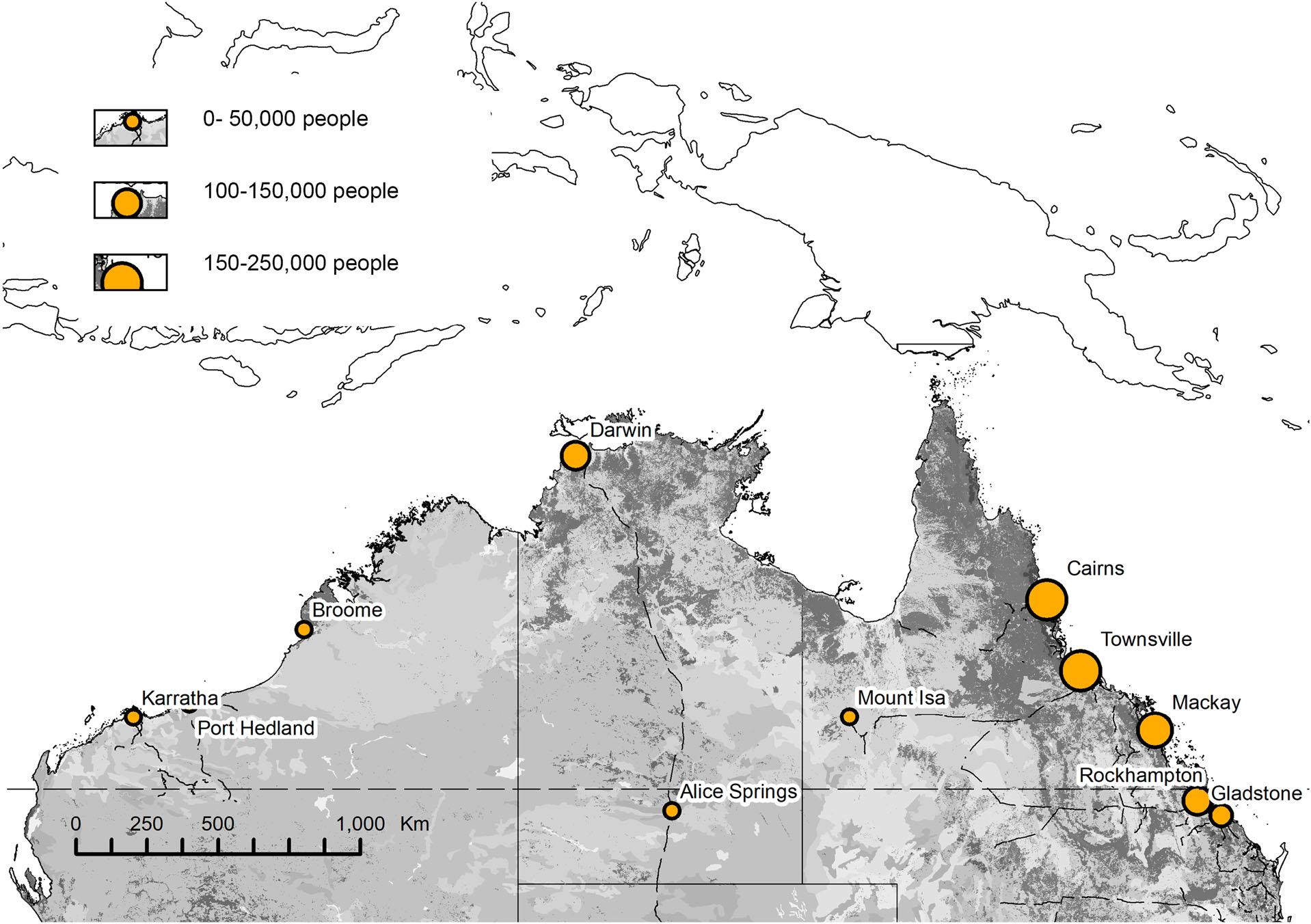
Figure1. NorthernAustraliaexistingtownsandcitiesbypopulation:Despiteitsgenerallysparsehabitation,northernAustralia does,containanumberofsmallcitiesandmajortowns.Planbytheauthor.
scaleeconomy;moreofapilotprojectthanapowerhouse.Weneedtolaythefoundationsforrapidpopulationgrowthandputthenorthonatrajectoryto reachapopulationoffourto fivemillionby2060. (AustralianGovernment 2015,4)
GivennorthernAustralia’scurrentpopulationof 1,3,000,000(AustralianGovernment 2015,134),this representsanalmostfour-foldincreaseinpopulation (anadditional3,700,000people).Thesubsequent expansionintheurbanarearequiredisequivalentto 22newTownsvilles,36newDarwins,or253new Broomes – allwithinthenext43years.Inthisrespect thewhitepaperambiguouslyrefersto ‘thedevelopmentofmajorpopulationcentresofmorethana millionpeople’ (AustralianGovernment 2015,3) –suchcitieswouldbesixtimesthesizeofthecurrentlargestcityTownsville,whichhasapopulationof170,000 people.
ThereisarichhistoryinAustraliaofprojecting over-ambitioustargetsforpopulationgrowth.Onthe 1888centenaryofthearrivaloftheFirstFleetinSydney,acorrespondentforthe Spectator newspaper notedthat ‘Thereiseveryreasonableprobabilitythat in1988AustraliawillbeaFederalRepublic,peopled by50,000,000Englishspeakingmen’ (Soutphommasane 2012,132).Subsequently,othershaveambitiously pitchedAustralia’scarryingcapacityasbeingashighas 500,000,000(Cathcart 2010) – aprojectionmadejust
aftertheFirstWorldWar – dwarfingAustralia’ scurrentpopulationof23,000,000byafactorof20.NorthernAustraliahasbeenthebackdropforsuch projectionsaswell.Inthemid-1980s,theNorthern TerritoryGovernmentestablishedamanufacturing TradeDevelopmentZone(TDZ),inDarwin.The NorthernTerritoryGovernmentinvestedmorethan $26,000,000incapitalworkintheTDZ,hopingto expandDarwininto ‘acityof2,750,000people’ by 2010(WuandWinchester 2015,259) – itscurrent populationbeingjustover100,000.
Thecurrentcity,stateorterritoryplanningofthe northdoesnotcountenancethescaleofpopulation growthprojectedinthegovernment’swhitepaper ‘Ournorth,ourfuture’.Eventhe2017 ‘Ournorth, ourfuture’ Implementationreportreleasedbythe OfficeofNorthernAustraliahasminimalcommentary onnorthernsettlementpatterns(OfficeofNorthern Australia 2017,22).1 TheplanforCairnsandthesurroundingFarNorthQueenslandregionscopesthe periodto2031andanadditionalpopulationinthe Cairnsregionofonly100,000people(Queensland Government 2009,12).Similarly,theplanningscheme forTownsvillehasascopethatextendsto2031anda populationincreaseofonly110,000people(Townsville CityCouncil 2017,3).Moreover,the ‘StrategicPlanfor Darwin’,preparedbytheCityofDarwin,onlyscopesa periodto2020andacomparativelyminorpopulation
increaseof22,000people(CityofDarwin 2012,18) –despitebeingbilledasthe ‘long-termvisionfor Darwin’ (CityofDarwin 2012,22).AswithAustralia generally,planningcontinuestobeorganisedona city-by-cityandstateandterritorybasis(Freestone 2014,7),andassuchisspatiallyfragmented.
Thisresearchpaperisimportantbecausethecoincidenceof(potentially)rapidpopulationgrowth,arelativelackoflong-termplanning,anda ‘natural landscapewitharichbiodiversityofinternationalsignificance ’ (Nixetal. 2013,85)areconcerning.Biodiversitylossesandspeciesextinctionsoverthenext centuryareexpectedtobehigh,driveninpartbyclimatechangeandlandusechangesthatconvertnatural vegetationtourbanuses(Dorningetal. 2015,28;Villarrealetal. 2013,90).Thisisparticularlythecasein relationtourbanisationontheoutskirtsofcitiesthat frequentlyoverlapwithlocationsrichinbiodiversity (Dorningetal. 2015,28),suchasinnorthernAustralia. Moreover,thisresearchisimportantbecausenorthern AustraliancitiessuchasDarwin,andtownssuchas PortHedland,experienceelevatedlevelsofsocioeconomicstratificationbetweencentralandfringing urbanareas.Forreasonsofsocietalinclusivityand cohesiveness,itiscrucialthatpotentiallyrapidlygrowingcitiesinnorthernAustraliadonotcompoundthis issue.
Withtheseissuesinmind,thisresearchpaperexplores thefollowingresearchquestion:
WhatarethepossibleenvironmentalandsocietalconsequencesofdifferentdistributionsofanorthernAustralianpopulationof5,000,000?
Whilethecredibilityofthefederalgovernment’ s populationprojectionsfor2060isdebatable,given thatAustralia’soverallpopulationisofficiallyprojected todoubleto42,400,000inthesametimeperiod – and tripleto70,100,000by21012 (AustralianBureauof Statistics 2013) – suchanapparentlymodestincrease ofpopulationinnorthernAustraliaisconceivable overthelongerterm.Toexploretheimplicationsof thisscaleofpopulationgrowthinnorthernAustralia, thefollowingsectionsetsoutthreescenarios,which distributethispotentialpopulationof5,000,000in differentforms.
This ‘singlethemed’3 scenarioplanningexercise (XiangandClarke 2003,897) – inwhichpopulation distributionformsthedominantdimension – builds onpreviousland-developmentscenarioswhichhave ‘beenintheplanner’stoolkitforseveraldecades’ (Chakrabortyetal. 2011,251;XiangandClarke 2003, 885).Inessence,itprovidesspatialrepresentationsof possiblefutureurbanurbanisationandlandscape change(Villarrealetal. 2013,90),whichcouldresult
fromparticularpopulationdistributions.Itisintended thatthisprocesswillexposedifferentwaysofthinking aboutaccommodatingpopulationgrowthinthenorth, inawaythatcanopenadialoguearoundthisissue,not prescribea ‘correctanswer’ (Logg-Scarvell,Navis,and Patrick 2015,51).
Inansweringthisresearchquestion,weconsider threedifferentscenariosforhowthefederalgovernmentcouldseektodistributethisnorthernAustralian populationof5,000,000by2060(AustralianGovernment 2015) – andwhichwebelieveareplausible (Figure2).Wehaveconstructedscenario1 ‘growth’ ontheassumptionthatpopulationgrowthwillmagnify theexistingdistributionofurbanpopulationinnorthernAustralia,i.e.,thatthefourbiggesturbancentres willcontinuetogetbigger.Inthisscenario,economic andlifestylefactorsconcentratetheincreasedpopulationofnorthernAustralianinthefourdominant northerncitiesDarwin,Cairns,TownsvilleandMackay – allwhichwouldhavepopulationsjustover1,000,000 by2060.
Wehaveconstructedscenario2 ‘decentralised growth’ ontheassumptionthatfederalplanningfor thedecentralisationofurbanpopulationwillachieve relativepopulation ‘balance’ acrossnorthernAustralia, i.e.federal,stateandterritorygovernmentswilldecant populationgrowthacrosstheeightbiggesturban centresinnorthernAustralia.Inthisscenario,topdowngovernmentplanning – typicaloftheDepartmentofUrbanandRegionalDevelopmentinthe 1970s(Oakley 2004) – seesPortHedland,Broome, Kununurra,Darwin,Cairns,Bowen,Townsvilleand McKayincreaseinpopulationby462,000peopleeach.
Wehaveconstructedscenario3 ‘concentrated growth’ ontheassumptionthattheprimacyofcapital citieswhichcharacterisespopulationdistribution acrosssouthernAustralia(Freestone 2013)willapply innorthernAustralia,i.e.populationgrowthisconcentratedinaprimatecity.Inthisscenarioeconomic opportunitiesseenorthernAustralia’sgrowingpopulationconcentratedinDarwin,the ‘ unofficialcapital ofthenorth’ , whichwouldgrowby1,500,000people by2060,reachingatotalof1,622,000.This figureis commensuratewiththeAustralianfederalgovernment’s2015visionofnortherncitieswith ‘morethan amillionpeople’ by2060(AustralianGovernment 2015,3).Theothercitiesofthenorthwouldaccommodatetheremaining2,200,000peoplecollectively.These threescenariosprovidereasonablecoverageacrossa spectrumoffutures.
Inunderstandingtheenvironmentalconsequences ofthesedifferentscenarioswehaveconducteda McHargianlandscapeanalysis(McHarg 1971)ofthe peri-urbanregionsofthenorthernAustralia’smajor cities(Darwin,Cairns,TownsvilleandMackay)to understandwhatlandcouldbeurbanisedtoaccommodatetheincreasedpopulationofthevariousscenarios

Figure2. Scenariooverview.Inthispaper,weconsiderthreedifferentscenariosforhowthefederalgovernmentcouldseekto distributeanorthernAustralianpopulationof3,700,000additionalpeopleby2060.
(Figure3).Areassuitableforurbanexpansionwehave definedasthosethatdonotcontainremnantvegetation,foreshore flats, flats,watercoursesorexcessivelysteeptopography,arenotpronetobushfires, arenotdesignatedreservesandarewithin50kmof existingcitycentres.Thismethodderivesfromconservationplanninginwhichconservationpriorityareas areprotected,essentiallyremovingthemfromeligibilityfordevelopment(Dorningetal. 2015,29;Forman 2010,200)(Figures4–7).Suchaconservationplanning approachisrelevantinthenorthofAustraliagenerally becausethenorthisan ‘extraordinarilyvast,natural landscapewitharichbiodiversityofinternationalsignificance ’ (Nixetal. 2013,85).
WehaveconductedthisgeospatialanalysisprincipallyusingtheGeoscienceAustralia1:250,000data set(GeoscienceAustralia 2018),aGeoscienceAustralia (1secondSRTM)DigitalElevationmodel(Australia 2010)and firescarmappinginrelationtobush fires (NationalClimateChangeAdaptionResearchFacility 2018).Thislandscapeanalysisleavesuspotentially developableareasthatwemeasuretoestimatetheir capacitytoabsorbtheFederalgovernmentproposed populationgrowth.
Forman’sanalysispointstoaclearorderingofthe urbanisationmodelsfrombesttoworstintermsof theireffectsonbiodiversity:(1)satellitecities;(2)concentriczones;(3)transportationcorridorsand(4)dispersedsites.Urbanisationindispersedsites surroundingametropolitanareacancauseextensive nature-and-humanresourcedegradation,andthus plannersandpolicymakersshouldavoidorminimise thisstrategy.Widestripsofdevelopmentalonghighwaycorridors(3)usuallydegradecreeksandrivers crossingtheregion,andblockmovementpatternsof certainkeywildlifespecies,leavingthemsemi-isolated insmallersectionsoftheregion(Forman 2010,221). WeuseForman’sorderingtoassess,inbroad-brush terms,thepotentialimpactsonbiodiversity.
Inunderstandingthesocietalconsequencesofthe differentscenariosweconsiderthelengthofsprawl oftheurbanformwhichresultsfromthisprocess andreflectontheabilityofgovernmenttoefficiently serviceitwithpublictransportandthusprovide accessforresidentsinnewareastotheemployment opportunities,culturalattractionsandconveniences oftheexistingurbancentres.Wealsoconsiderthe abilityofresidentsofnewurbanareastoaccessthe naturalamenityofthecoastline.Bothofthesecriteria areimportant,andpublictransportandaccessto naturalamenityaredefiningfactorsofacity’sliveability(TheEconomistIntelligenceUnitLimited 2012,8).Moreover,therearenumerousexamples innorthernAustraliawheregovernmentshave
Presumingdevelopersdevelopthisremainingarea, wethenconsidertheimpactsonbiodiversityofthis urbanform.Thebroad-brushanalysisweconductin relationtorenownedurbanecologistRichardForman’ s foururbanmodelsforaccommodatingurbangrowth. The firstis ‘satellitecities’ whichinvolvesfocusing urbanisationconcurrentlyaroundsatellitecitiesinan urbanregiontohelptoprotectthelandnearadominantmetropolitanareawhichmaybeofconsiderable ecologicalimportance(Forman 2010,201).Thesecond is ‘concentriczones’ whichinvolvesconcentricyet compactgrowtharoundanexistingcity(Forman 2010,202).Thethirdis ‘transportationcorridors’ and involvesstripdevelopmentalongamajorradialtransportationcorridorwhichprogressivelysubdividesthe landscape(Forman 2010,201).Thefourthis ‘dispersed sites’ whichinvolvesdisperseddevelopmentandproducesawidezoneofrelativelylow-densitydevelopment,orsprawl,aroundthecity(Forman 2010,202) (Figure8).
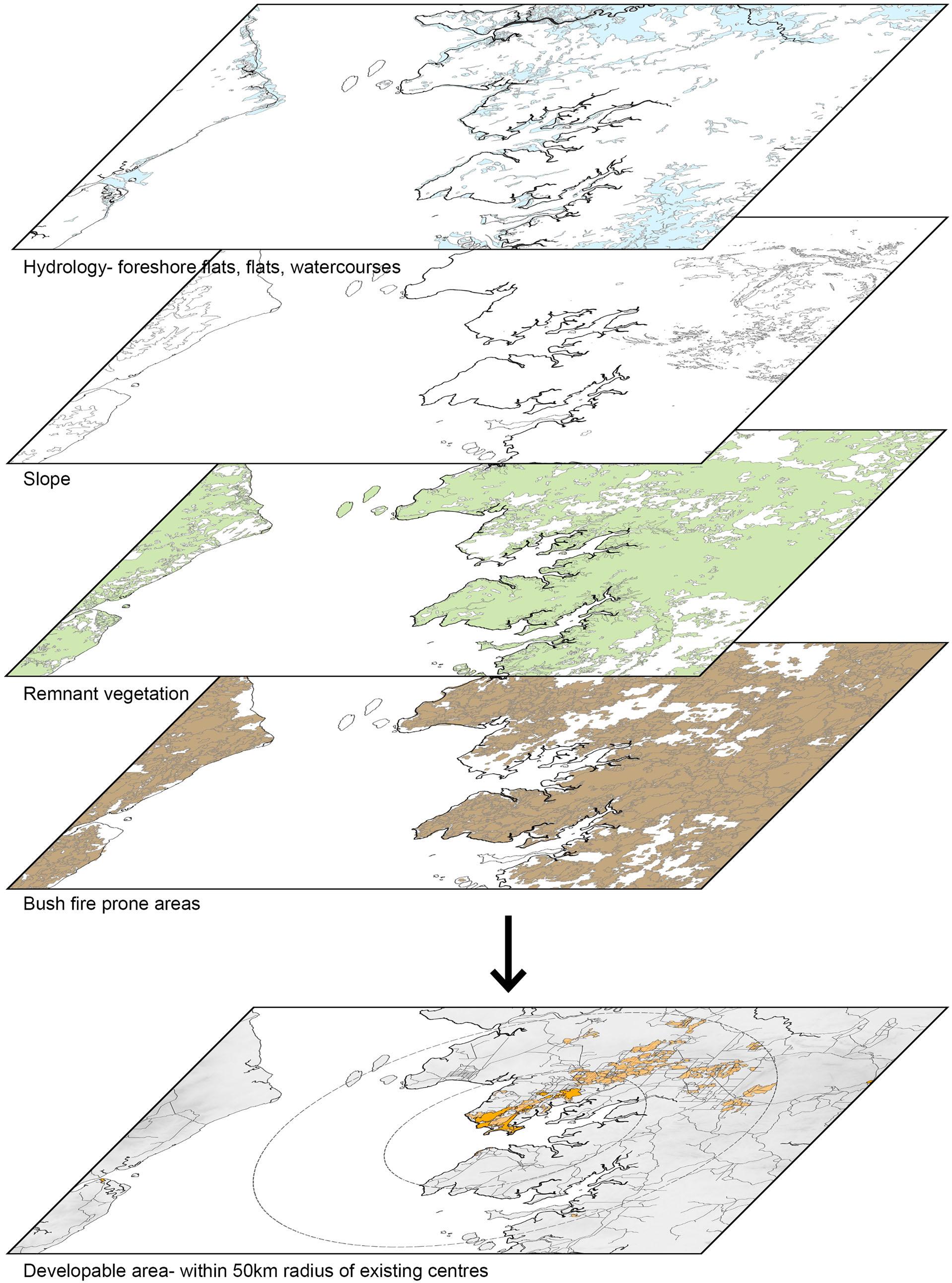
Figure3. McHargianlandscapeanalysis.Inthispaper,wehaveusedaMcHargiananalysistodeterminethecapacityoftheperiurbanregionsofnorthernAustralia’scitiestoaccommodateurbanexpansion.
struggledtoconnectfar-flungsuburbswithdominant citycentres,andthishasresultedinelevatedlevelsof socio-economicdisadvantagebeingconcentredin outersuburbs.ExamplesincludetheDarwinsuburb ofPalmerston,theRadburn-plannedsuburbofPort Hedland,SouthHedland(Neilson 1983,91),and theHeavitreeGapsuburbofAliceSprings(Carter 2016,94).
Inestimatingthedegreeof ‘sprawl ’ ineachscenario,wehaveusedapopulationdensityof1000

Figure4. Darwinconstraints.AMcHargianlandscapeanalysisoftheperi-urbanareasofDarwinrevealssubstantialconstraintsto urbanisationsuchaslowlying flatsandforeshore flatsandremnantvegetation:Key1.Darwinbuiltuparea;2.ShoalBayCoastal Reserve;3.MelaccaSwampConservationArea;4.MantonDam;5.LitchfieldNationalPark.

Figure5. Cairnsconstraints.AMcHargianlandscapeanalysisoftheperi-urbanareasofCairnsrevealssubstantialconstraintsto urbanisationsuchasdesignatedreserves,forestsandsignificanttopographicfeatures:Key1.LittleMulgraveNationalPark;2.KurandaNationalPark;3.BilwonForestReserve;4.BaldyMountain.
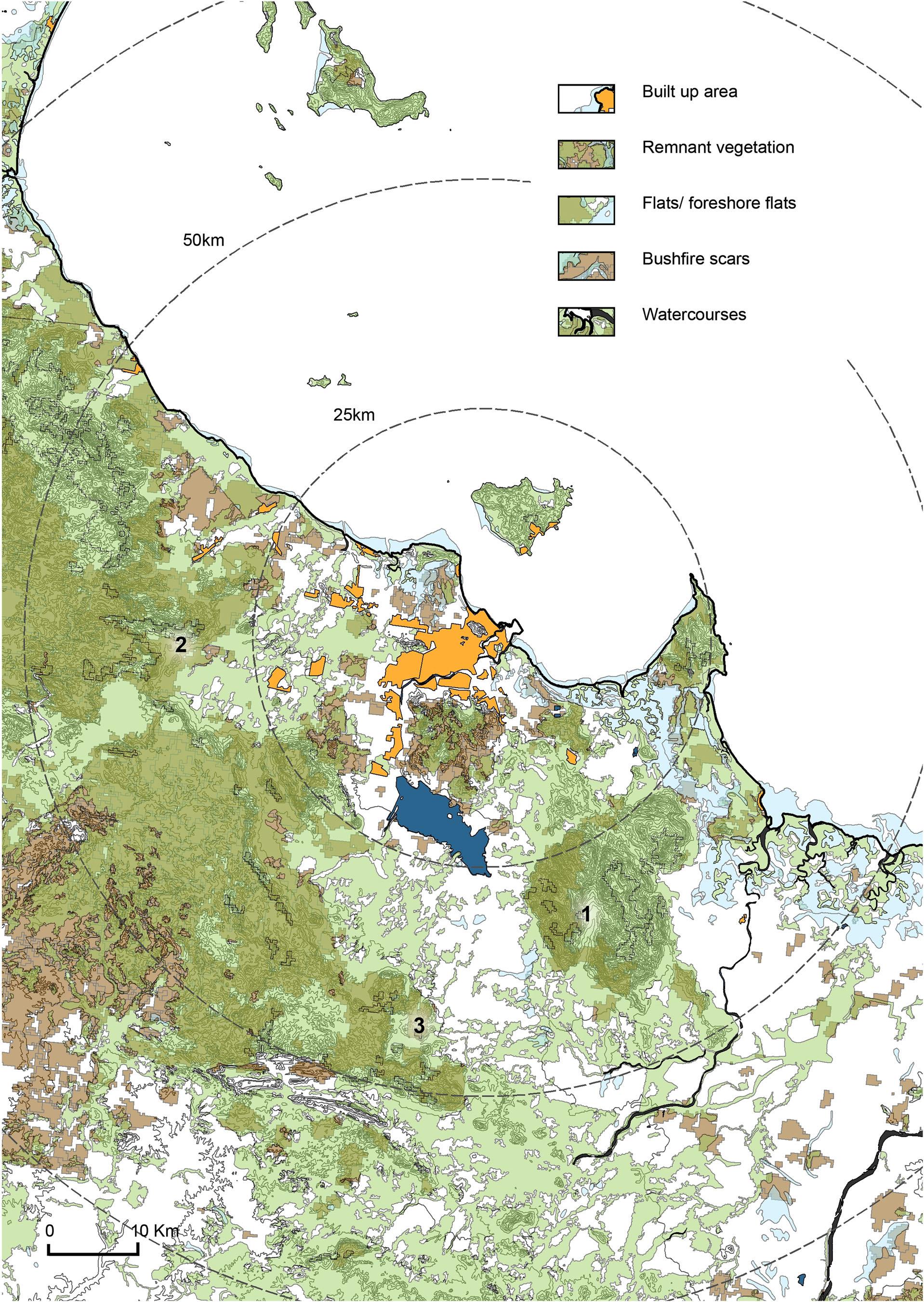
Figure6. TownsvilleConstraints.AMcHargianlandscapeanalysisoftheperi-urbanareasofTownsvillerevealssubstantialconstraintstourbanisationsuchaslowlyingforeshore flats,designatedreserves,forestsandsigni ficanttopographicfeatures:Key 1.MountSurroundShirbourne;2.MountCateract;3.MingelaStateForest.

Figure7. Mackayconstraints.AMcHargianlandscapeanalysisoftheperi-urbanareasofMackayrevealsthatithassubstantial reservesoflandforpotentialurbanisation:Key1.CapePalmerston;2.BenMohrStateForest;3.MountCharlton.
peoplepersquarekilometretohousetheincreased populationsinthethreescenarios.Thisdensityis broadlycommensuratewithAustraliancitiessuchas Townsville,Brisbane,PerthandtheGoldCoast, whichareamongsttheleastdenselysettledinthe world(Hunn 2017 ).
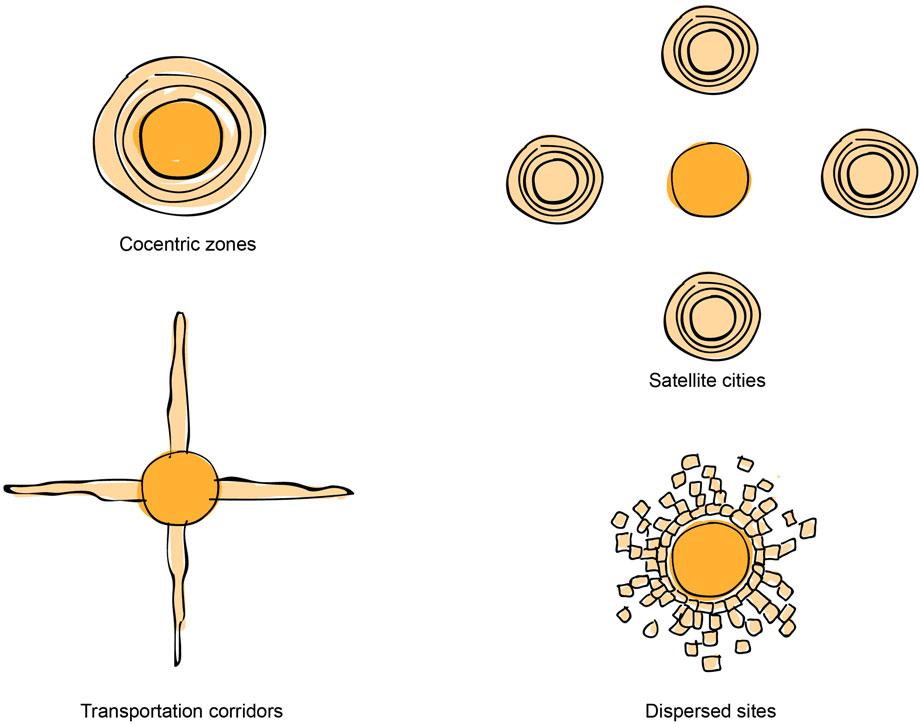
Figure8. Modelsofurbanexpansion.Thisdiagramshows RichardTForman’smodelsforurbanexpansion.Forman’s analysispointstoaclearorderingoftheurbanisationmodels frombesttoworstintermsoftheireffectsonbiodiversity: (1)satellitecities;(2)concentriczones;(3)transportationcorridorsand(4)dispersedsites.
Scenario1:Growth
Inthisscenario,earlytwenty-first-centurytrends towardseconomiccentralisationandprimacy4 inAustraliancitiescontinue,andthereforenorthernpopulationgrowthprincipallyoccursinthenorth’sfour majorcities.ThisresultsinasituationwherethedominantnortherncitiesDarwin,Cairns,Townsvilleand Mackayallhavepopulationsoverjustover1,000,000 by2060.Suchdominantgatewaycities,by2060,are commensurateinpopulationsizewiththeAustralian federalgovernment’s2015visionofnortherncities with ‘morethanamillionpeople’ (AustralianGovernment 2015,3).Asagateway, ‘beta’ globalcities,these centrescouldbecomeinstrumentalinlinkingtheir respectiveterritoriesintotheworldeconomy(Gussen 2017,27)(Figure9).
ThisadditionalpopulationforDarwin,Cairns, TownsvilleandMackayrequires925km2 ofurban expansionineachcityregion.Atthesametimethe amountofunconstrainedlandinDarwin,Cairns, TownsvilleandMackayis296,1798,957and 2303km2,respectively(withina50kmradiusofthe existingcitycentres).Thispointstoobviousgrowth capacityissuesinDarwinandTownsville(Figure10).
Thisextremegrowthinthemajorcitiesofthe north – a900%increaseintheirexistingpopulation sizeinfourdecades – isconcerningparticularlyif policymakersandplannersdonotcomprehensively planforitduetothespatialfragmentationofplanning,limitedtimeframesandalackofbipartisan agreementbetweenopposingfederalandstategovernments.Asaresult,itcouldleadtoseveralnegativeoutcomes.
Environmentalandsocietalimplicationsfor Darwin
TheaddedpopulationforDarwinrequires925km2 of urbanexpansion,atthesametimeDarwinhasonly 296km2 ofnon-constrainedland(withina50km radiusoftheexistingcitycentre)(Figure11).Theresult ofthiscouldbethatdevelopersconductlarge-scale clearingofremnantvegetationtocreatetherequired areaofurbanisation.Darwinwouldalsosprawlinthe formofForman’ s ‘transportationcorridor’ model whichwouldlikelydegradecreeksandriverscrossing theregionandblockmovementpatternsofcertain keywildlifespecies(Forman 2010,221).
Thesocietalimplicationsofthislevelofgrowth couldbenegative.Ifforestedorwaterloggedlandscapes wererespectedDarwinwouldsprawlintheformofa longcorridorvirtuallyconnectingDarwintoHumpty DooandAcaciaHills.Thissprawlwouldbedifficult toservewithpublictransport(duetothelengthofthe corridorform)andwouldofferpooraccesstothe coastandtheculturalamenityandjobswhichDarwin’ s citycentreoffers,aswellaspotentiallyconcentrating socio-economicdeprivationinfar-flunginlandsuburbs.
TheaddedpopulationforCairnsrequires925km2 of urbanexpansionandCairnshas1798km2 ofnonconstrainedland(withina50kmradiusoftheexistingcitycentre)(Figure12).Nonetheless,ifplanning andconstraintsprotectedforested, flood-proneand steeplandscapesfromurbandevelopmentCairns wouldrequirethedevelopmentofinlandareas(in thevicinityofMareeba,AthertonandGordonvale) intheformofForman’s(4)dispersedsitesmodel (4)andurbandevelopmentwouldalsosprawlina ‘transportationcorridor’ model(3)alongthecoastal striptoBabinda,
Thiscorridordevelopmentalongthecoastwould degradecreeksandriverscrossingtheregion,and blockmovementpatternsofcertainkeywildlifespecies (Forman 2010,221).Thedispersedsuburbsinlandof Cairn’sexistingcitycentrewouldbedifficulttoserve witheffectivepublictransportandwouldofferpoor accesstothejobsofthecitycentreandthenatural amenityofthecoastandinlandareas.
TheadditionalpopulationforTownsvillerequires 925km2 ofurbanexpansionwhichisroughlycommensuratewithTownsville’s957km2 ofnon-constrainedland(withina50kmradiusoftheexisting citycentre)(Figure13).Theadditional925km2 of urbanisationrequiredinthisscenariowouldmean Townsvillewouldsprawl,tosomedegree,intheform
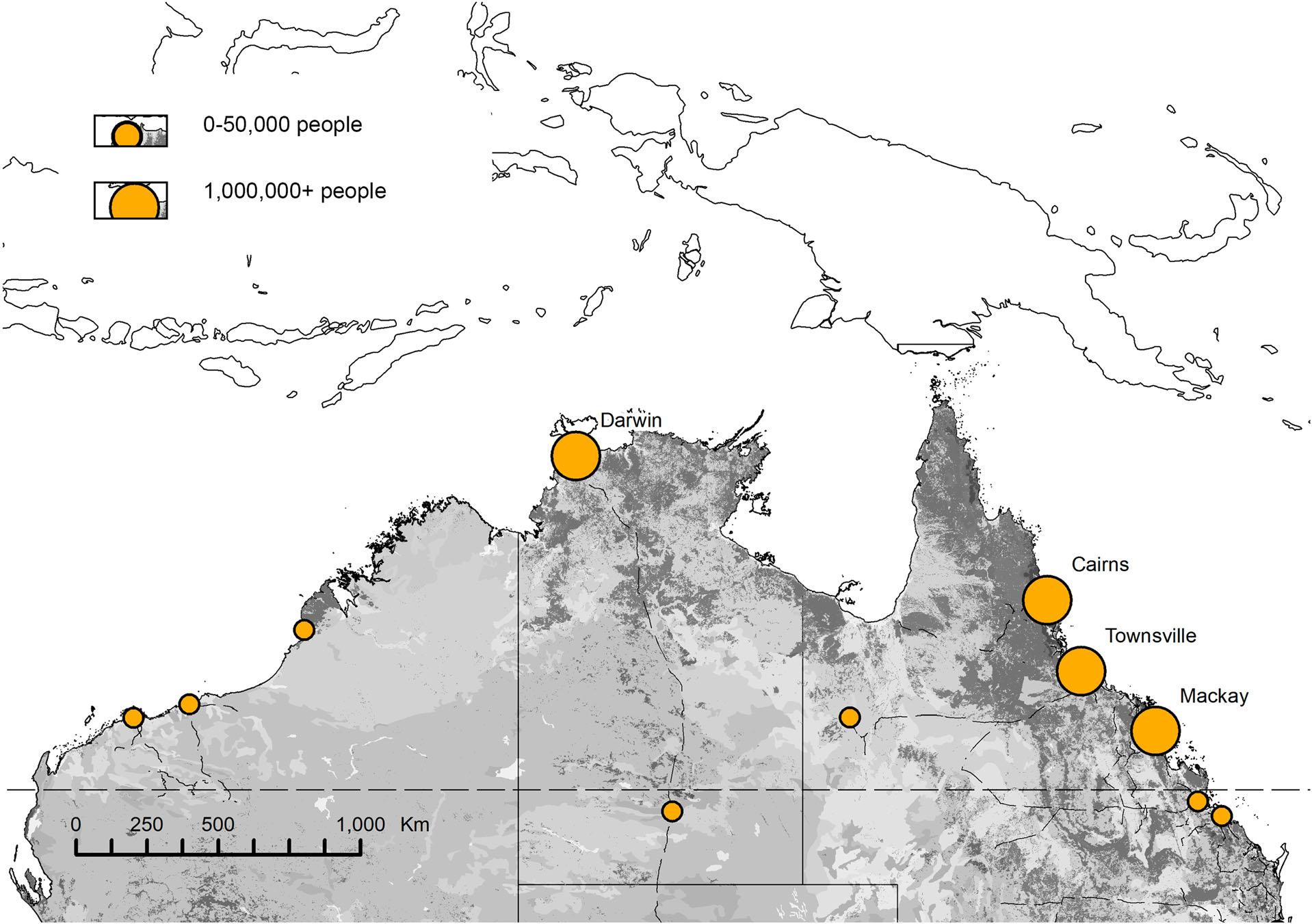
Figure9. Scenario1:Growth.Inthisscenario,northernpopulationgrowthprincipallyoccursinthenorth’sfourmajorcities.This resultsinasituationwherethedominantnortherncitiesDarwin,Cairns,TownsvilleandMackay(andadjacenttowns)allhavepopulationsoverjustover1,000,000by2060Planbytheauthor.
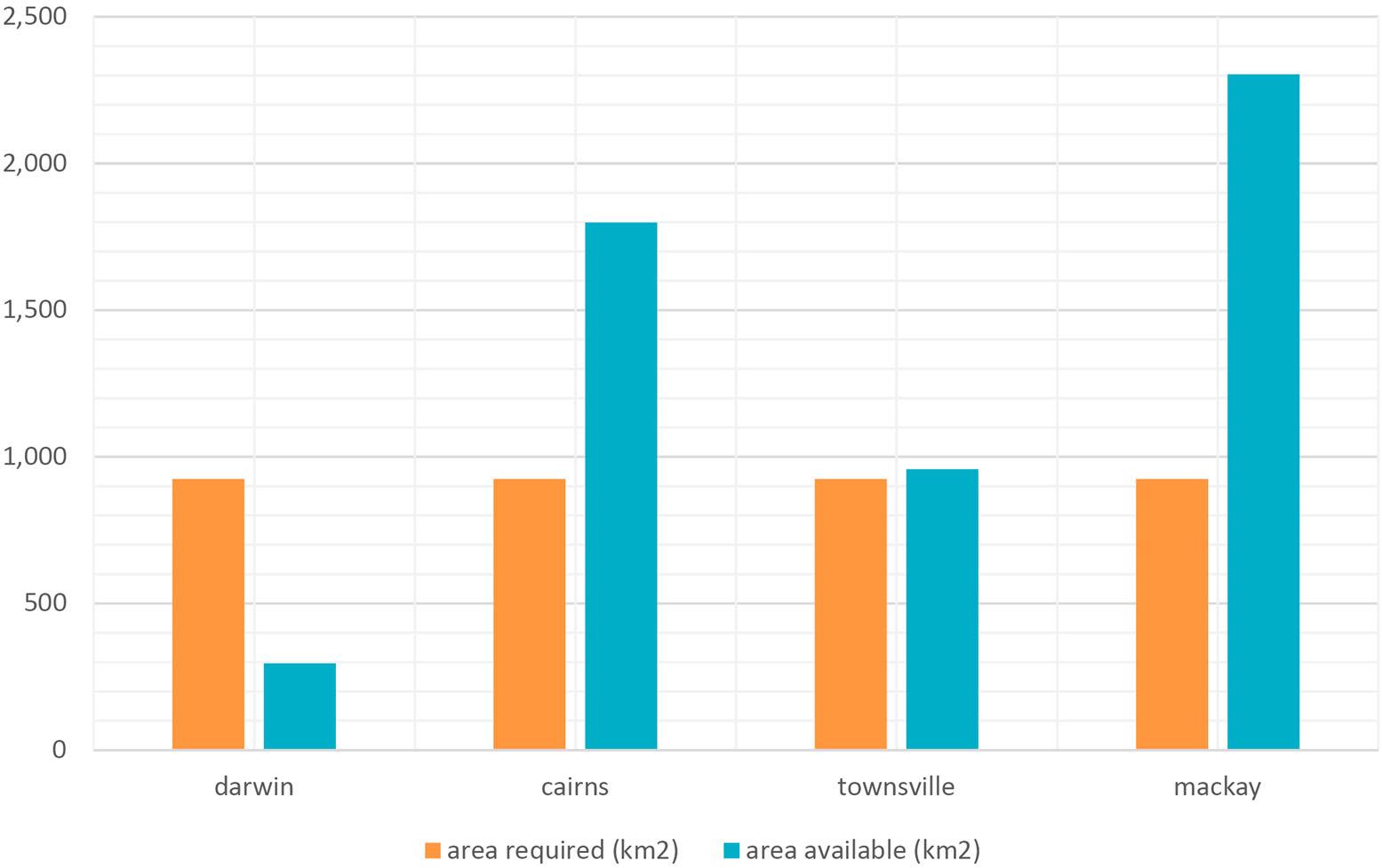
Figure10. Scenario1:Growth.Thisgraphshowsthecapacityforurbanexpansionbycity:thisgraphshowsgrowthcapacityissues inDarwinandTownsville.
ofForman’ s ‘transportationcorridors’ modelalongthe coastandina ‘dispersedsites’ modelaroundtheexistingcentresofGiruandWoodstock,totheeastand westofMountSurround.Thesedispersedsuburbs (nearGiruandWoodstock)couldsuffermanyofthe sameaccessibilityofthosesurroundingCairnsand accordingtoFormancouldcauseextensivenatureand-humanresourcedegradation(Forman 2010,221).
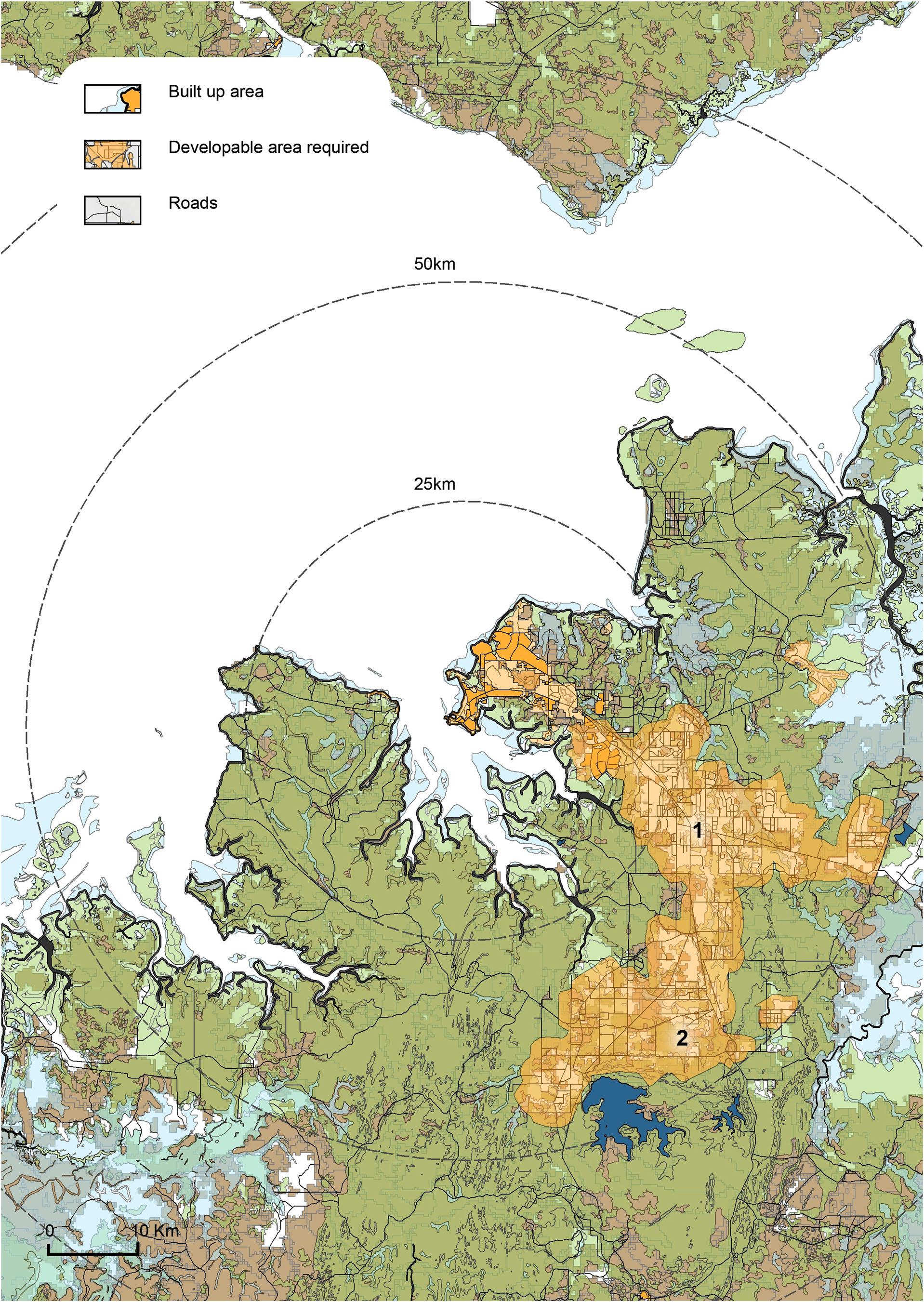
Figure11. Scenario1:Growth – Darwin.Theadditional925km2 ofurbanisationrequiredinthisscenariowouldmeanDarwin wouldsprawlintheformofaForman’s ‘transportationcorridor’ modelasfarasHumptyDoo(1)andAcaciaHills(2).
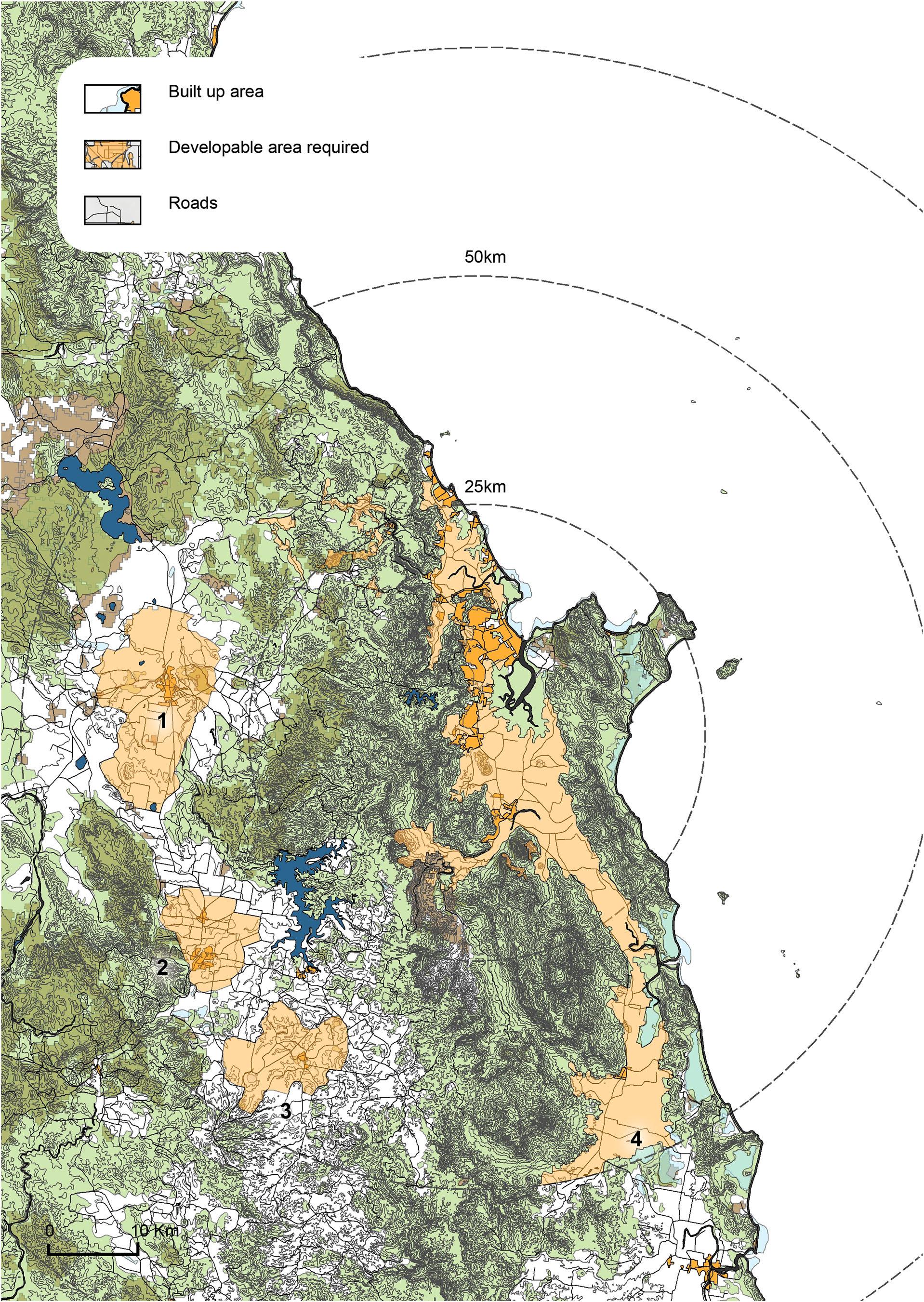
Figure12. Scenario1:Growth – Cairns.Theadditional925km2 ofurbanisationrequiredinthisscenariowouldmeanCairnswould sprawlintheformofaForman’s ‘transportationcorridors ’ modelasfarasBabinda(4)andina ‘dispersedsites’ modelaroundthe existingcentresofMareeba(1),Atherton(2)andMalanda(3).

Figure13. Scenario1:Growth – Townsville.Theadditional925km2 ofurbanisationrequiredinthisscenariowouldmeanCairns wouldsprawl,tosomedegree,inForman’s ‘transportationcorridors’ modelalongthecoastandina ‘dispersedsites’ modelaround theexistingcentresofGiru(1)andWoodstock(2),totheeastandwestofMountSurround(3).

Figure14. Scenario1:Growth – Mackay.TheadditionalpopulationforMackayrequires925km2 howeverMackayshouldbeableto easilyaccommodatesuchgrowth.ThisgrowthcouldseetheareasaroundMarian(1)andAlligatorCreek(2)urbanisedinwhat Formandescribesasthe ‘concentriczones’ model.
Environmentalandsocietalimplicationsfor Mackay
TheadditionalpopulationforMackayrequires 925km2 ofurbandevelopment;however,Mackay shouldbeabletoeasilyaccommodatesuchgrowthin thesubstantialamountofunconstrainedlandwithin a50kmradiusoftheexistingurbancentre(Figure14). Populationgrowthofthisscalecouldseetheareas aroundMarian(1)andAlligatorCreek(2)urbanised inwhatFormandescribesasthe ‘concentriczones’ model(Forman 2010,202)whichgovernmentscould fairlyeasilyservicewithpublictransportandwhich shouldnotcausesubstantialenvironmental degradation.
Summationofscenario1implications
ExceptforMackay,theprevalenceofForman’ s ‘transportationcorridors’ and ‘dispersedsites’ modelin Darwin,MackayandTownsvilleisconcerningfrom anenvironmentalandsocietalperspective.Inthis scenario,theriskisthatultimatelythegrowthofDarwin,CairnsandTownsville,inparticular,could degradethenaturalamenitywhichatcurrentisthe region’stourismandmigrationdrawcard(Bohnet andPert 2010,239).Moreover,thisextremepopulationgrowthcouldleadtoresentmentfromexisting residentstowardsbothoverseasandAustralianimmigrantsthattheyregardasthreateningtheaccessthe relaxedlifestyleandaccesstonatureoriginally offeredbythesecomparativelysmallcities(Bohnet andPert 2010,246).Thesecitiescouldalsobecome heavilystratifiedbetweenthosewhocanaffordhousinginconvenientandamenableinnerandmiddle areasandthoseconsignedtopoorlyconnected outersuburbs.
Inthisscenariofederal,stateandterritorygovernments distributetheincreasedpopulationofnorthernAustralianintotheeightmostsignificanturbancentres.Asa result,PortHedland,Broome,Kununurra,Darwin, Cairns,Bowen,TownsvilleandMcKaywouldincrease inpopulationby462,000peopleeach(Figure15).The urbanexpansion – percentre – requiredtocontainthis additionalpopulationwouldbe462km2.Againthese projectionsarebasedonalowpopulationdensityof 1000peoplepersquarekilometrefoundinAustralian citiessuchasBrisbane,PerthandtheGoldCoast (Hunn 2017).
Afederalgovernment-driven ‘NorthernCities’ taskforcecoulddeliversuchapatternofpopulationdistributionifitwasauthorisedtodelineatefutureurban growthareas,establishspatiallimitsforexisting centres,andcoordinatecityinfrastructurespending (Haratsis 2010,248)inamannerthatisreminiscent oftheDepartmentofUrbanandRegional
Developmentfromthe1970s(Oakley 2004,299).The delineationoffuturegrowthareaswouldneedtobe determinedbyasystematicanalysisofenablinginfrastructuresuchasexistingportsandinternationalairports,securewatersupplies,economicdevelopment prospects,climate,distancefromcoast,presentpopulation,environmentalfragility,andhumancarrying capacity5 (Cocks 1992,216).
Significantfederalgovernmentinvestmentininfrastructurewouldassistinenablingthedecentralisation ofpopulationgrowth.Suchinvestmentscouldinclude theforgingofapassengerandfreightrailnetwork betweenBroomeandKarrathaonthewestcoast(connectionthe ‘lifestylecity’ ofBroometotheeconomic powerhouseofthePilbaraandthedeep-waterportat PortHedland6)andanupgradedpassengerandfreight linebetweenCairnsandRockhampton(reflectinga similarlifestyletoeconomicpowerhousedynamic). AnefficientregionalrailservicefromPortHedland toBroometripwouldtake3hoursandtheCairnsto Rockhampton5hours.Complementingtheserailconnectionscouldbearegionalrailspurlinefromthe AdelaidetoDarwinraillinetoWyndhamandKununurratoDarwin.ThiscouldconnectthecityofDarwin withthesignificantlyexpandedOrdRiverIrrigation areathatprovidesthecitywithmuchofitsfood.
Theurbanexpansion – percentre – requiredtocontain theadditionalpopulationinthisscenariowouldbe 462km2.Thisamountofurbanexpansionposesissues forDarwin(themostconstrainedofthenortherncities withonly296km2 ofdevelopableland)butcouldcomfortablybeaccommodatedinCairns(1798km2), Townsville(957km2)andMackay(2303km2)which allhavesubstantialreservesofnon-constrainedland (withina50kmradiusoftheexistingcitycentres)for thisexpansiontooccur(Figure16).WhileDarwin wouldsprawlinatransportationcorridorswhich degradescreeksandriverscrossingtheregion,and blocksmovementpatternsofcertainkeywildlifespecies – Cairns,TownsvilleandMackayshouldbeableto accommodatethisgrowthinForman’sconcentric zonesmodelwhichinvolvesconcentricyetcompact growtharoundanexistingcity(2010,202)and shouldn’tleadtoextensiveenvironmentaldegradation.
Moreover,themoderatesizeofthesecitiesthat resultfromthisscenariocouldbeoptimalfornorthern Australiainthattheypotentiallyofferaccesstonatural amenityaswellasabalanceofjobopportunities,housingaffordability,income,schoolsizes,healthservices andlowcrimerates(MacDonald 2017).Moreover, thismodelofcompact,concentricsmall-sizedcities shouldbecomparativelyeasytoservewithpublic transportandshouldnotentrenchmajorsocio-economicdivisionsbetweencitycentreandperipheral suburbs.

Figure15. Scenario2:Decentralisedgrowth.Inthisscenariofederal,stateandterritorygovernmentsdistributetheincreasedpopulationofnorthernAustralianintotheeightmostsignificanturbancentres.Asaresult,PortHedland,Broome,Kununurra,Darwin, Cairns,Bowen,TownsvilleandMcKaywouldincreaseinpopulationby462,000peopleeach.
Importantlythroughestablishingsuchanetworked regionalstructureofeightcities,governmentscould foster ‘anurbanandruraldynamic’ whichisableto both ‘maintainhome-growncapacitylocallyand
attracthumancapitalfromelsewhere’ (Dale 2014, 139).Moreover,suchconnectionscouldbeofvital importancetoindigenousyouthandyoungadultsin remotecommunitieswhomsometimesareindesperate

Figure16. Scenario2:Decentralisedgrowth.Thisgraphshowsthecapacityforurbanexpansionbycity.Inthisscenario,thegraph revealscapacityissuesonlyinDarwin – theothercitieshavingcomparativelyhigheramountsofnon-constrainedlandforpotential urbanisation.
needofanescaperoutefromchronicdisadvantage (Raupachetal. 2012,29).
Inthisthirdscenario,thepresenceofeconomicopportunitiesconcentratesnorthernAustralia’sgrowing populationinDarwin,the ‘ unofficialcapitalofthe north’,whichwouldgrowby1,500,000peopleby 2060,reachingatotalof1,622,000(Figure17).This figureiscommensuratewiththeAustralianfederal government’s2015visionofnortherncitieswith ‘morethanamillionpeople’ by2060(AustralianGovernment 2015,3).Theothercitiesofthenorthwould accommodatetheremaining2,200,000people.This growthofpopulationinDarwincouldreflectthe ‘balanceandorientation’ ofthenationshiftingnorthwards (Carroll 2005,178).Moreover,itcouldbe,inpart,precipitatedbybuildingahigh-speedraillinkconnection Darwintothesoutherncities(Carroll 2005,178).
ADarwinof1,622,000wouldprobablyfunctionasa betalevelcityandwouldlikelybeinstrumentalinlinkingtheNorthernTerritoryintotheworldeconomy (Gussen 2017,27).Whilenotafullalphaglobalcity, itwould,tosomedegree,competeforglobalcapital andworkerswithothersmallercitiesintheadjacent region(Gussen 2017,26).ReflectingthisDarwin’ s
economycouldbepartlydrivenby ‘advancedproducer services’ includeaccounting,advertising, finance, insurance,andlawdeliveredtotheregion(Gussen 2017,26).ComplimentingtheserolescouldbeDarwin’sprominenceasanAustralianhubforglobaltertiaryeducationprovision(BolleterandWeller 2013) aswellasahubforadministeringresourceextraction operations.Reflectingthesedrivers,Darwin’ spopulationcouldcontinuetoberichlymulti-culturaland thecityagatewaytothe ‘AsianCentury’
Environmentalandsocietalimplications
Theurbanexpansionrequiredtocontainthisadditional populationforDarwinis1500km2 whichwoulddwarf Darwin’s296km2 ofdevelopablelandwithin50kmof theexistingcitycentre – butwouldcertainlytakethe pressureoff theothercities(Figure18).Nonetheless, Darwinwouldsprawlinatransportationcorridors model.Thisispotentiallyamajorissuefromabiodiversityperspectivebecausewidestripsofdevelopment alonghighwaycorridorsdegradecreeksandriverscrossingtheregion,andblockmovementpatternsofcertain keywildlifespecies(Forman 2010,221),moreoverthe citywouldinevitablysprawlintoareasofremnantvegetationandlowlying, flood-proneland – bothwhich wouldcauseextensiveenvironmentaldegradation (Figure19).

Figure17. Scenario3:Concentratedgrowth.Inthisthirdscenario,thepresenceofeconomicopportunitiesconcentratesnorthern Australia’sgrowingpopulationinDarwin,the ‘unofficialcapitalofthenorth’,whichwouldgrowby1,500,000peopleby2060, reachingatotalof1,622,000.

Figure18. Scenario3:Concentratedgrowth.Thisgraphshowsthecapacityforurbanexpansionbycity:thisgraphshowsgrowth capacityissuesinonlyinDarwinduetothelimitedavailabilityofunconstrainedland.Whilethisscenariowouldcausesignificant issuesforDarwinitcouldcertainlytakethepressureoff theothercities.
Givenitsconstrainedsite,theurbanexpansion requiredtocontainthisgrowthcouldoccurmuch furtherthan50kmfromtheexistingcentreofDarwin whenwemeasurethisdistancealongtheroadnetwork. Thistenuousconnectionbetweenoutersuburbsand citycentrecouldleadtosocio-economicstratification, asitwouldbedifficulttoservethesefringingsuburbs witheffectivepublictransportandassuchprovide theirresidentswithaccesstotheculturalamenity andjobopportunitiesofDarwin’scitycentre.While Darwin’sextremelyrapidgrowthcouldtakethe pressureoff othercitiesinthenorth,itcouldhowever alsotendtotrapmostfederalandinternationalinvestmentintheregion,andassuchlittleinvestmentwould makeitswaytoregionalareasofthenorth – possibly leadingtosomeresentmentfromotherpopulation centresandregions.
Discussion
Thereisnoone ‘correct’ settlementpatternfornorthernAustralia(Logg-Scarvell,Navis,andPatrick 2015, 51).Indeed,overthelongerterm,theanswerliesina hybridisedapproachthatutilisesthebestaspectsof thescenarios1and2inrelationtochangingconditions – suchasclimatechange,economicfortunes,governance,geopoliticsanddisruptivetransporttechnologies, amongstothers.
However,givenwhatwecurrentlyknow – inthe shortterm,buildingontheexistingstrengthsofthe majornortherncitiesmakesmuchsense(scenario1) – ifweemployaconcentriczonesmodel(Forman 2010,221).Thesecitiesarewheresubstantialinvestmentininfrastructurehasoccurredtodateand,ashis-
torytellsus,weshouldfullyutilisetheseinvestments beforelaunchingoff intotheregionsinregionalcity buildingexercises(Lonsdale 1972).Withprudentplanningofthesecitiesusingaconcentriczonesmodel, thereisalsonoreasontheliveability,economicviability,andvibrancyofthesecitiescannot flourish,at leastwithmeasuredincreasesinpopulation.
Overthelongerterm,giventheconstrainedsitesof citiessuchasDarwin,CairnsandTownsville,andlikely communityresistancetodramaticpopulation increases,therewillbespatialandsocietallimitsto theirpotentialgrowth,andassuchopportunitiesfor boostingotherregionalcentrestocitystatus(scenario 2) – inForman’ssatellitecitiesmodel(Forman 2010, 221).Anticipatingthetimingofthesetippingpoints – wheredecentralisationfromthenorth’slargercities toregionalcentreswillbecomefeasible – isnotoriously difficult.Nonetheless,itmaybethatthetippingpoints fornortherncitiesarearrivedatmuchearlierthanhas beenthecaseinthesouth;assuch,thismayoccurwell beforethenorth’scitiesreachapopulationofjustover amillionpeople(asdiscussedinrelationtoscenario1). Ofcourse,thedecentralisationofpopulationfrom thesedominantnortherncitieswillalsorequirea strongideallynationalplanningframeworkstocoordinatethispopulationdistributioninamannerwhichis efficientandequitable(Haratsis 2010,218).
Irrespectiveofthesettlementpatternscenario,withoutoverarching,longtermplanningframeworksto steerurbanisationinthenorth,populationgrowth willyieldnegativeenvironmentalandsocietaloutcomes(asscenarios1and3highlight).Boththe ‘Our north,ourfuture’ whitepaper,andtherelated implementationreport(OfficeofNorthernAustralia
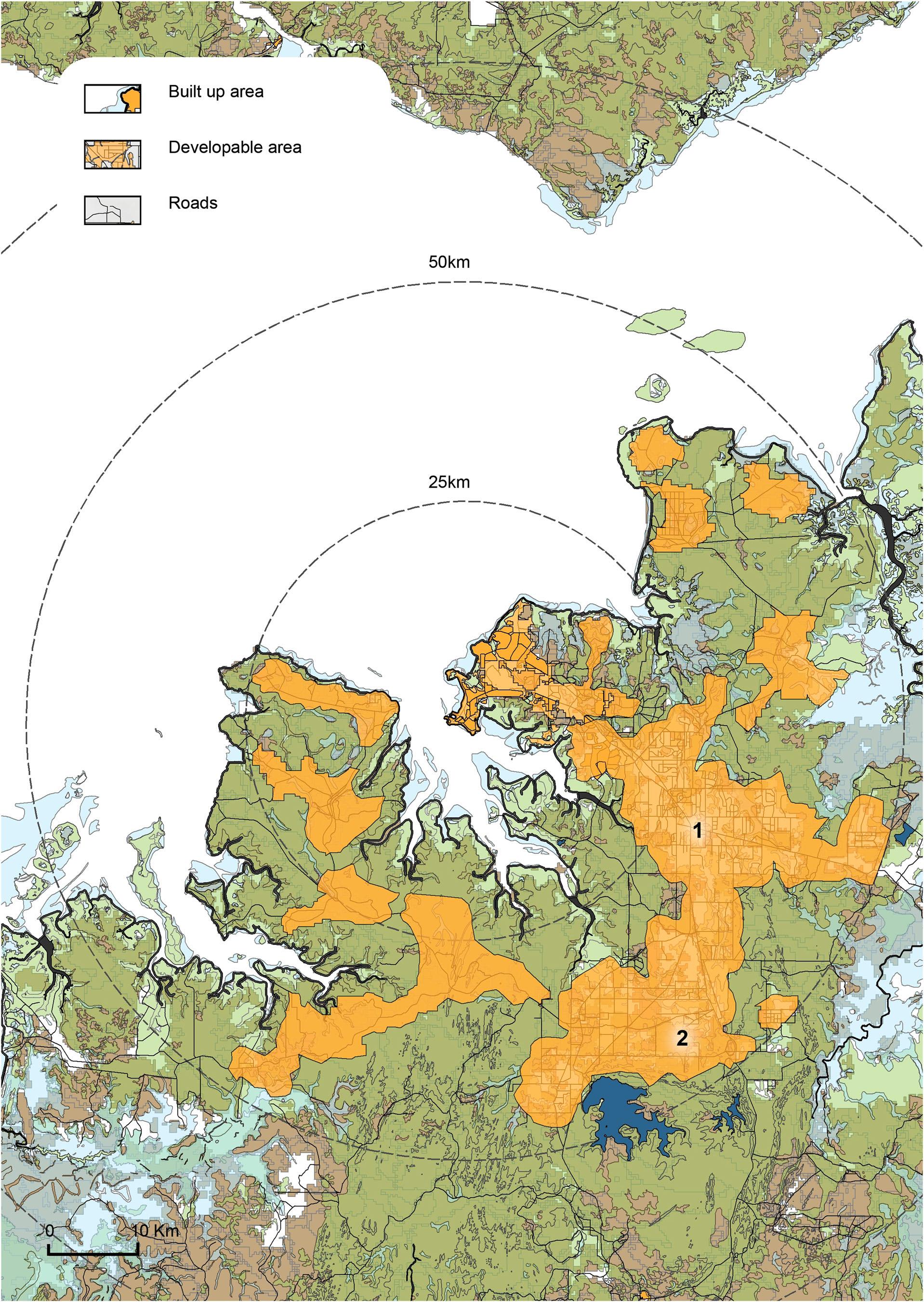
Figure19. Scenario3 – Darwin.Inthisscenario,theurbanexpansionrequiredtocontainthisadditionalpopulationforDarwinis 1500km2 whichwoulddwarfDarwin’s296km2 ofdevelopablelandwithin50kmoftheexistingcitycentre.Ifplannersrespected theareasexistingvegetationandforeshore flatsthecitywouldsprawlinatransportationcorridorsmodelasfarasHumptyDoo(1) andAcaciaHills(2).
&AustralianGovernmentDepartmentofIndustry 2017) – lackthislong-term,holisticspatialplanning offuturesettlementpatterns.
Suchanoverarchingplanningframeworkrequiresa partnershipbetweenfederal,state/territory,andlocal governmentstodeviseandimplementabipartisan settlementstrategytosteertheurbanisationofnorthernAustralia.Policymakersandplannersshould developthisplaninrelationtoacomprehensivelandscapeanalysisofnorthernAustraliatounderstand whichspatialareashavethehighestcarryingcapacity, securewatersupplies,economicopportunity,and existinginfrastructuresuchasportsandairportsas wellasenvironmentalfragility – ananalysissimilar tothatwhichCSIROscientistDougCockscarried outin1992(Cocks 1992,216).
BrendanGleesonentitlessuchanoverarchingplanningframework,an ‘AustraliaPlan’ (2010,133),and BrianHaratsisproposesitcoulddelineatefuture urbangrowthareas,establishspatiallimitsforexisting cities,andbecoordinatedwithaninfrastructureplan directingnationalandglobalinfrastructurespending (2010,248).Onekeyaspectofsuchaplanshouldbe tolaythegroundworkforthedecentralisationofpopulationfromthedominantcitiesinthenorth – forwhen thetimeisright(scenario2).Thisdecentralisationis likelytobethemostopportuneintermsofmaintaining theliveabilityofexistingcitiesbutalsocausetheleast environmentaldegradation(Forman 2010,218).The scaleofplanning,asembodiedbyanAustraliaPlan (orsimilar),wouldbedependentonarenewedfederal governmentinvolvementinurbanmatters,reminiscentoftheDepartmentofUrbanandRegionalDevelopmentfromthe1970s(Oakley 2004,299).Whilean AustraliaPlanhasobviousvirtues,itissomething thatwouldbeextremelydifficulttoreconcilewiththe currentpoliticalclimate.Nonetheless,theneedfor thisscaleofplanningremains.
Regardlessofthepatternofpopulationdistribution inthenorth,apopulationof5,000,000coulddramaticallyoutstripthecarryingcapacityoftheland(Lane 2017).In2017,researchbyLanerevealedthateven thecurrentmeagrepopulationsoftheNorthernTerritoryandthenorthofWesternAustraliahavealready significantlyexceededthelandscape’scarrying capacity.Infact,theonlyareaofnorthernAustralia thathasn’toutstrippeditscarryingcapacityisthe ‘NorthernGulf’ regioneastofCairns(Lane 2017). WhilesouthernAustraliaalsohasissuesinthisrespect, particularlyalongtheeasternseaboard,theseissues paleincomparisontothoseinnorthernAustralia. Fromapopulationcarryingcapacityperspective,the federalgovernmentshoulddecidewhetherapopulationof5,000,000inthenorthissomethingthatwe shouldaspiretoatall.7 Moreover,inthelongerterm, iftheworstclimatechangeprojectionsareborneout, somedirectedmigrationfromfarnortherncities
suchasDarwintocitiesfurthersouthorindeedthe southernstatesmaybenecessary.Ofcourse,thisall dependsonourabilitytoreducecarbonemissions andlimitglobaltemperaturerise,forwhichthereexists amultitudeofprojectionsandopinions(Climate HomeNews 2017).
Thispaperhasadvancedthreepotentialscenarios foranorthernAustralianpopulationofupto 5,000,000,asprojectedinthe ‘Ournorth,ourfuture’ report(AustralianGovernment 2015,4).Thesescenariosraisethepossibledetrimentalsocietaland environmentaleffectsofthisscaleofpopulation growth,particularlyifnotplannedforinaholistic, long-termmanner.Wehaveintendedthispaperto actasabriefingtothedisciplineofplanninginAustralia – whichshouldbeconcernedwiththeseevolving issuesandlobbyinggovernmentthroughtheinstitute.
Notes
1.Itdoes,however,referto ‘CityDeals’ policy(recently establishedbytheAustralianGovernment)inwhich ‘thethreelevelsofgovernment,thecommunityand privateenterprise … worktoaligntheplanning, investmentandgovernancenecessarytoaccelerate growthandjobcreation,stimulateurbanrenewal anddriveeconomicreforms.’ Whileamuch-needed initiative,thispolicyiscity-speci ficandnotgeared todeliveringbroaderregionalsettlementpatterns (DepartmentofthePrimeMinisterandCabinet 2017).
2.Theseare ‘seriesA’ projectionsandarethehighestof thethreesetsofprojectionstheAustralianBureauof Statisticsproduces.
3.Usually,asingle-themedscenariosetcomprisestwoor threescenarios(XiangandClarke 2003,898).
4.Primacyreferstotheconcentrationofpopulationin thecapitalcities.Australiagenerallyexhibitsavery highdegreeofprimacywith64%ofAustraliansliving inthestatecapitalcities(Hugo 2012,18).
5.SuchacomprehensiveanalysiswasconductedbywellrespectedCSIROscientistDougCocksin1992(Cocks 1992,216).Cocks’ mappingandselectionofsitefor futureurbangrowthunderpinthis ‘decentralised growth’ scenario.
6.OnlyPortHeadlandandTownsvillehavesignificant deepwaterports(ProjectGutenberg 2017).
7.Thecurrentlimitedcarryingcapacityofthenorth meansthatDarwinhasAustralia’shighestecological footprintperperson(7.1hectares)comparedto southerncitiessuchasMelbourne(6.4hectares)or Hobart(5.7hectares)(TurnerandForan 2008,36).
Disclosurestatement
Nopotentialconflictofinterestwasreportedbytheauthor.
References
Australia,G. 2010 GeoscienceAustralia,1SecondSRTM DigitalElevationModel(DEM) https://data.gov.au/data/ dataset/9a9284b6-eb45-4a13-97d0-91bf25f1187b
AustralianBureauofStatistics. 2013 PopulationProjections, Australia,2012to2101 http://www.abs.gov.au/ausstats/ abs@.nsf/Lookup/3222.0main+features5201220 (base)20to%202101.
AustralianGovernment. 2015. OurNorth,OurFuture: WhitePaperonDevelopingNorthern Australia.Canberra:AustralianGovernment.
Bohnet,I.C.,andP.L.Pert. 2010 “Patterns,Driversand ImpactsofUrbanGrowth – AStudyfromCairns, Queensland,AustraliaFrom1952to2031.” Landscape andUrbanPlanning 97(4):239–248.
Bolleter,J.,andR.Weller. 2013 MadeinAustralia:The FutureofAustralianCities.Perth:UniversityofWestern AustraliaPublishing.
Carroll,J. 2005 “DeveloptheNorth.” GriffithReview 9(86). Carter,P. 2016 “Lines.” PostcolonialStudies 19(1):94–96. Cathcart,M. 2010. TheWaterDreamers:TheRemarkable HistoryofOurDryContinent.Melbourne:Text Publishing.
Chakraborty,A.,N.Kaza,G.-J.Knaap,andB.Deal. 2011. “RobustPlansandContingentPlans:ScenarioPlanning foranUncertainWorld.” JournaloftheAmerican PlanningAssociation 77(3):251–266. CityofDarwin. 2012 EvolvingDarwinTowards2020: StrategicPlan.Darwin:CityofDarwin. ClimateHomeNews. 2017 GlobalCarbonEmissionsRisein 2017,DrivenbyChina http://www.climatechangenews. com/2017/11/13/global-emissions-expected-rise-2017-sayresearchers/ Cocks,D. 1992 UsewithCare.Sydney:NewSouthWales UniversityPress. Cohen,S.B. 2000. “The PolyurbanFrontierinPost-industrialIsrael. ” In DevelopingFrontierCities,editedbyH. LithwickandY.Gradus,255–271.London:Springer.
Dale,A. 2014. BeyondtheNorth-southCultureWars: ReconcilingNorthernAustralia’sRecentPastwithIts Future.NewYork:Springer. DepartmentofthePrimeMinisterandCabinet. 2017 Smart CitiesPlan https://cities.dpmc.gov.au/ Dorning,M.A.,J.Koch,D.A.Shoemaker,andR.K. Meentemeyer. 2015 “SimulatingUrbanizationScenarios RevealsTradeoffsBetweenConservationPlanning Strategies. ” LandscapeandUrbanPlanning 136:28–39. TheEconomistIntelligenceUnitLimited. 2012 BestCities RankingandReport:ASpecialReportfromthe EconomistIntelligenceUnit.London:TheEconomist IntelligenceUnitLimited.
Forman,R. 2010. UrbanRegions:EcologyandPlanning BeyondtheCity.Cambridge:CambridgeUniversityPress. Freestone,R. 2013. “BacktotheFuture.” In Madein Australia:TheFutureofAustralianCities,editedbyJ. BolleterandR.Weller,236–243.Perth:Universityof WesternAustraliaPress.
Freestone,R. 2014 “ProgressinAustralianPlanningHistory: Traditions,ThemesandTransformations.” Progressin Planning 91:1–29.
GeoscienceAustralia. 2018 GeodataTopo250KSeries3 –(PersonalGeodatabaseFormat) https://ecat.ga.gov.au/ geonetwork/srv/eng/catalog.search?node=srv#/metadata/ 63999
Gleeson,B. 2010 LifeboatCities.Sydney:UNSWPress.
Gussen,B.F. 2017. “CanCharterCities ‘Anabolise’ the AustralianFederation?” PublicAdministrationand Policy 20(1):18–38.
Haratsis,B.P. 2010. Australia2050:BigAustralia? Adelaide: DigitalPrintAustralia.
Hugo,G. 2012 PopulationDistribution,Migrationand ClimateChangeinAustralia:AnExploration.Urban Management,TransportandSocialInclusion,1–101. Canberra:NationalClimateChangeAdaptionResearch Facility.
Hunn,P. 2017 AustralianCitiesamongtheLargestandLeast DenselySettledintheWorld https://architectureau.com/ articles/australian-cities-among-the-largest-and-leastdensely-settled-in-the-world/
Lane,M. 2017 “ExploringShort-TermandLong-TermTime FramesinAustralianPopulationCarryingCapacity Assessment.” PopulationandEnvironment 38(3):309–324. Logg-Scarvell,J.,R.Navis,andK.Patrick. 2015 “Scenarios forAustraliain2050:ASynthesisandProposed Survey.” JournalofFuturesStudies 19(3):49–76. Lonsdale,R. 1972 “ManufacturingDecentralization:The DiscouragingRecordinAustralia.” LandEconomics 48 (4):321–328.
MacDonald,E. 2017. CityMoreLiveablethanCairns, Brisbane. http://liveablecities.org.au/city-more-liveablethan-cairns-brisbane/ McHarg,I. 1971 DesignwithNature.NewYork:Doubleday/ NaturalHistoryPress.
NationalClimateChangeAdaptionResearchFacility. 2018 FireData – FireScarMaps http://nccarf.jcu.edu.au/ terrestrialbiodiversity/index.php/43-fire/172-fire-data-firescar-maps.html
Neilson, L. 1983 “HowLocalGovernmentComesto CompanyTowns.” AustralianPlanner 21(4):91–92. Nix,H.,B.Mackey,B.Traill,andJ.Woinarski. 2013 The NatureofNorthernAustralia:ItsNaturalValues, EcologicalProcessesandFutureProspects.Acton:ANU Press. Oakley,S. 2004 . “ PoliticsofRecollection:Examining theRiseandFallofDURDandBetterCities ThroughNarrative.” UrbanPolicyandResearch 22(3): 299–314.
O
fficeofNorthernAustralia. 2017 OurNorth,OurFuture: DevelopingNorthernAustralia2017Implementation Report.Canberra:OfficeofNorthernAustralia.
OfficeofNorthernAustralia&AustralianGovernment DepartmentofIndustry,InnovationandScience. 2017 OurNorth,OurFuture:DevelopingNorthernAustralia 2017ImplementationReport.Canberra:Officeof NorthernAustralia&AustralianGovernment DepartmentofIndustry,InnovationandScience. ProjectGutenberg. 2017. ListofDeepWaterPorts. http://self.gutenberg.org/articles/eng/List_of_deep_water_ ports. QueenslandGovernment. 2009. FarNorthQueensland RegionalPlan2009–2031:PlanningforaStronger,More LiveableandSustainableCommunity.Brisbane: QueenslandGovernment.
Raupach,M.,A.McMichael,K.Alford,E.Fulton,J. Finnigan,N.Grigg,andB.Walker. 2012 “Living ScenariosforAustraliaasanAdaptiveSystem.” In NegotiatingOurFuture:LivingScenariosforAustraliato 2050,editedbyM.Raupach,A.McMichael,J.Finnigan, L.Manderson,andB.Walker,1–53.Canberra: AustralianAcademyofScience.
Roux,A.,M.Faubell,andD.McGauchie. 2014 Northern Development:CreatingtheFutureAustralia.Melbourne: ADCForum.
Soutphommasane,T. 2012. Don’tGoBacktoWhereYou Camefrom:WhyMulticulturalismWorks.Sydney: Newsouth.
TownsvilleCityCouncil. 2017 PlanningTogetherfor Townsville ’sFuture.Townsville:TownsvilleCityCouncil. Turner,G.,andB.Foran. 2008. ResourceConsumptionand ResourceDepletion.Melbourne:CSIROPublishingand Dordrecht:Springer. Villarreal,M.L.,L.M.Norman,K.G.Boykin,andC.S. Wallace. 2013 “BiodiversityLossesandConservation Trade-offs:AssessingFutureUrbanGrowthScenarios foraNorthAmericanTradeCorridor.” International
JournalofBiodiversityScience,EcosystemServices& Management 9(2):90–103. Wu,J.,andH.P.Winchester. 2015. “Globalisationand BorderDynamics:ImpactsontheUrbanDevelopment ofDarwin,Australia.” AustralianGeographer 46(2): 255–270.
Xiang,W.-N.,andK.C.Clarke. 2003 “TheUseofScenarios inLand-UsePlanning.” EnvironmentandPlanningB: PlanningandDesign 30(6):885–909.